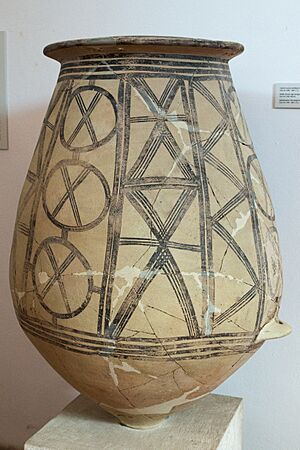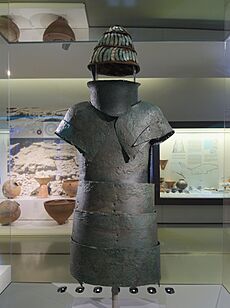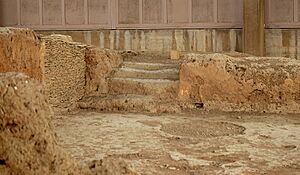Helladic chronology facts for kids
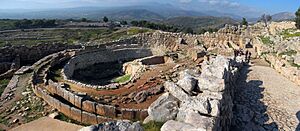 |
|
| Period | Bronze Age |
|---|---|
| Dates | c. 3200 BC – c. 1050 BC |
| Major sites | Thebes, Tiryns, Mycenae |
| Preceded by | Neolithic Greece |
| Followed by | Greek Dark Ages |
Helladic chronology is a special way archaeologists and art historians figure out the age of things from the Bronze Age in mainland Greece. It's like a timeline system! This system works alongside the Minoan chronology (for Crete) and Cycladic chronology (for the Aegean islands).
All three systems help us understand how ancient cultures grew at the same time across the region. They are often grouped as "Aegean" cultures. These dating systems mostly rely on how pottery styles changed over time. Pottery is a great clue because it breaks easily but its pieces (called sherds) last a long time. By studying these pieces, experts can tell how old other items found with them might be.
The Helladic period covers a long time, from about 3200 BC to 1050 BC. It started after the Stone Age when people lived in small farming villages. Over time, people learned new skills like working with bronze, building big structures, and making fortifications. The later part of the Helladic period (around 1550 – 1050 BC) is often called the Mycenaean Age. This is because Mycenae was a very powerful city in Greece back then. After 1050 BC, the Aegean cultures faced a tough time, sometimes called a "Dark Age," possibly due to wars and invasions.
Contents
What Does "Helladic" Mean?
The words "Cycladic," "Helladic," and "Minoan" simply tell us where an ancient object came from. For example, if you find a pot made in the Minoan style on a Cycladic island, it's still a Minoan pot. It doesn't become Cycladic just because of where it was found. This system helps archaeologists keep track of where different cultural styles began.
How Do We Know the Dates?
Archaeologists have found lots of evidence, especially pottery, that shows similar ways of life across mainland Greece, the Cyclades, and Crete during the Bronze Age. This was a time before 3000 BC. As the Bronze Age continued, societies and economies grew faster.
Unlike ancient Egypt or Mesopotamia, the people in the Aegean region didn't have writing during the third millennium BC. This means we don't have old books or records to tell us dates. So, archaeologists have to rely on physical objects. Pottery was used everywhere and its pieces (called sherds) survive well. Because pottery styles and techniques changed over time, experts can classify them by age. When similar pottery is found in different places, it helps them match up timelines.
Helladic Time Periods
Archaeologists divide the Helladic period into three main parts: Early, Middle, and Late. To be even more specific, they use Roman numerals (I, II, III) for the next level, then letters (A, B, C), and then numbers (1, 2, 3). Not all levels are found at every ancient site.
Here's a simple breakdown of the Helladic periods and their approximate dates:
| Period | Approximate Date |
|---|---|
| Early Helladic I | 3200–2650 BC |
| Early Helladic II | 2650–2200 BC |
| Early Helladic III | 2200–2000 BC |
| Middle Helladic I | 2000–1900 BC |
| Middle Helladic II | 1900–1700 BC |
| Middle Helladic III | 1700–1550 BC |
| Late Helladic IA | 1550–1500 BC |
| Late Helladic IB | 1500–1450 BC |
| Late Helladic II | 1450–1400 BC |
| Late Helladic IIIA | 1400–1300 BC |
| Late Helladic IIIB | 1300–1200 BC |
| Late Helladic IIIC | 1200–1050 BC |
Early Helladic Period (EH)
The Early Helladic period is when people in Greece started using bronze and copper. They learned basic bronze-working skills from places like Anatolia (modern-day Turkey). This period happened at the same time as the Old Kingdom in Egypt.
Important Early Helladic sites are found along the Aegean coast, in areas like Boeotia and Argolid. These include Manika, Lerna, Thebes, and Tiryns. Pottery from these sites shows influences from western Anatolia. People also started using a faster potter's wheel. A new type of large house, called a megaron, appeared during EHII.
Early Helladic I (EHI)
The Early Helladic I period (around 3200–2650 BC) is known for its simple, polished pottery. Metal objects were very rare. Life continued much like the period before it, with some changes in where settlements were located, probably due to new farming methods.
Early Helladic II (EHII)
The move from EHI to Early Helladic II (around 2650–2200 BC) happened quickly. During this time, many new things developed. These included working with bronze, creating more organized societies, and building large structures and fortifications. Farming also changed, with people starting to use oxen to pull plows.
Early Helladic III (EHIII)
The Early Helladic II period ended with the destruction of important buildings, like the "House of the Tiles" at Lerna. At first, some thought this was due to invaders. However, experts now believe it was more complex. Not all sites were destroyed, and some cultural changes happened naturally. New types of houses and burial customs appeared. Climate changes also played a part in the big shifts that happened in Greece between EHII and Early Helladic III (around 2200–2000 BC).

Middle Helladic Period (MH)
The Middle Helladic period (around 2000–1550 BC) saw some cultural changes. A new type of pottery called "Minyan ware" became very common. This pottery was smooth and monochrome (one color).
Another important type of pottery from this period is "matt-painted pottery." Unlike Minyan ware, which was made on a wheel, matt-painted pottery was shaped by hand and had dull, painted designs. Many of its patterns, like zigzags and spirals, were inspired by pottery from the Cycladic islands and Crete. This suggests that the Middle Helladic people had strong connections with these other cultures.
Burial Customs
During the Middle Helladic period, people used four main types of graves:
- Pit graves: Simple holes in the ground.
- Tholos graves: Chamber-like tombs.
- Cist graves: Deep, rectangular graves with a mound of earth (tumulus) on top. These appeared early in the period.
- Shaft graves: Larger and deeper than cist graves (about 6 meters long, 4 meters wide, and 4 meters deep). These appeared later.
Babies were often buried in special jars called pithoi, which were about 75 cm tall. For adults, bodies were placed on their sides with knees bent (women on their left, men on their right). People at the ceremony would drink from cups and then leave them at the tomb. Valued items like pottery, silver, or bronze were also buried with the dead.
At the site of Lerna, over 200 graves have been found. Most bodies were buried inside the community, sometimes even with towns built around a cist grave.
Community Life
Middle Helladic communities, like Lerna, had houses packed closely together without a clear pattern. It's thought that people might have lived near their extended families or close friends. Houses were usually one story, shaped like a "U," and made of clay. They often had a porch, up to three rooms, an inner room with a fireplace, and spaces for storage and cooking. A larger, separate house might have belonged to a leader.
People grew crops like wheat, barley, flax, peas, and beans. They also raised animals such as sheep, goats, pigs, oxen, horses, and dogs. They spun thread and wove fabrics on looms, making clothes that were fastened and decorated with pins. They also wore necklaces and bracelets made of stone and shells.
Studies of skeletons from sites like Lerna show that men generally ate more protein and did more heavy physical labor than women. Men also had more signs of infectious diseases, suggesting they had more contact with outside groups. This indicates a division of labor between genders.
The Middle Helladic period happened at the same time as the Middle Kingdom of Egypt. Settlements often moved to hilltops. Important Middle Helladic sites include Malthi and Lerna V, which have been carefully excavated.
Late Helladic Period (LH)
The Late Helladic period is when Mycenaean Greece became very powerful. This culture was influenced by Minoan Crete and the Cycladic islands. People who made Late Helladic pottery sometimes wrote on their work using a script called Linear B. We now know that Linear B is an early form of the Greek language.
The Late Helladic period is divided into LHI, LHII, and LHIII. LHIII is further split into LHIIIA, LHIIIB, and LHIIIC. Here are the approximate dates for these phases:

| Period | Approximate Date |
|---|---|
| LHI | 1700–1600 BC |
| LHIIA | 1635–1470 BC |
| LHIIB | 1480–1410 BC |
| LHIIIA1 | 1420–1370 BC |
| LHIIIA2 | 1390–1315 BC |
| LHIIIB | 1330–1200 BC |
| LHIIIC (Early) | 1210–1160 BC |
| LHIIIC (Middle) | 1170–1100 BC |
| LHIIIC (Late) | 1100–1040 BC |
| Proto-Geometric | 1070–900 BC |
Late Helladic I (LHI)
LHI pottery has been found in the Shaft Graves at Lerna and in settlements like Voroulia and Nichoria. The eruption of the Thera volcano also happened during LHI (around 1650–1625 BC). After this eruption, a new style of pottery called "Peloponnesian LHI" appeared, with unique designs like spirals and wavy lines.
Late Helladic II (LHII)
The LHIIA period shows strong connections with Minoan Crete. By LHIIB, Cretan influences became less strong. This period in Greece matches the beginning of Egypt's "Imperial" period, the New Kingdom of Egypt, with pharaohs like Hatshepsut and Thutmose III.
Late Helladic III (LHIII)
LHIII pottery is very widespread and shows the expansion of Mycenaean culture across the Eastern Mediterranean. Many new pottery shapes appeared, and the painted designs became very standardized. In Egypt, LHIIIA:1 pottery was found during the reign of Amenhotep III, and LHIIIA:2 during his son Akhenaten's rule. LHIIIA:2 pottery was also found in the Uluburun shipwreck, which sank in the 14th century BC.
LHIIIB pottery is found in the Mycenaean palaces in Greece, along with the Linear B writing tablets. This period was a time when the Hittites in Anatolia and the 19th Dynasty (Ramessides) in Egypt were powerful. The end of LHIIIB is linked to the destruction of the city of Ugarit.
The LHIIIC period shows significant differences in pottery styles across different regions. Late LHIIIC pottery has been found in Troy VIIa and in early Philistine settlements like Ashdod and Gaza.
Fortified Settlements
During the Helladic period, people made big steps in building. They created fortified towns with impressive buildings called "corridor houses." These buildings suggest that societies were becoming more complex, possibly with leaders or early forms of city-states.
One example is Manika in Euboea, from the Early Helladic II period (2800–2200 BC). This settlement was huge, covering 70–80 hectares, and had an estimated population of 6,000–15,000 people. It was one of the largest Bronze Age settlements in Greece.
Another important site was Lerna in the Argolid region. It had a famous building called the "House of the Tiles," a "corridor house" known for its advanced features. Its roof was covered with baked tiles, which was very unusual for that time. This building dates to the Early Helladic II period (2500–2300 BC). Some think it was the home of a leader, an early palace, or an administrative center. Others believe it was a shared community building. We don't know its exact purpose because few small items were found inside. The house even had a stairway to a second story.
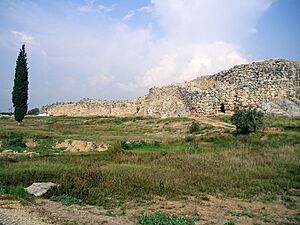
Other fortified settlements include Tiryns, which covered about 5.9 hectares and had a population of 1,180–1,770 people. Tiryns had a large, two-story "round house" on its upper citadel, possibly a palace or a place to store grain. Other sites like Ayia Irini, Eutresis, Thebes, Lefkandi, and Kolonna (or Aegina) also had strong fortifications and well-planned towns.
Kolonna, especially, showed great economic growth before 2500–2400 BC. It had its own administrative "Corridor House." Later, a larger "White House" served a similar purpose. Kolonna might have been the first "state" in the Aegean region outside of Minoan Crete, becoming a political center in the Middle Helladic period, even before the Mycenaeans.
See also
- History of Greece
- Linear B
- Mycenaean Greek
- Pelasgians
- Eutresis culture
- Bronze Age



